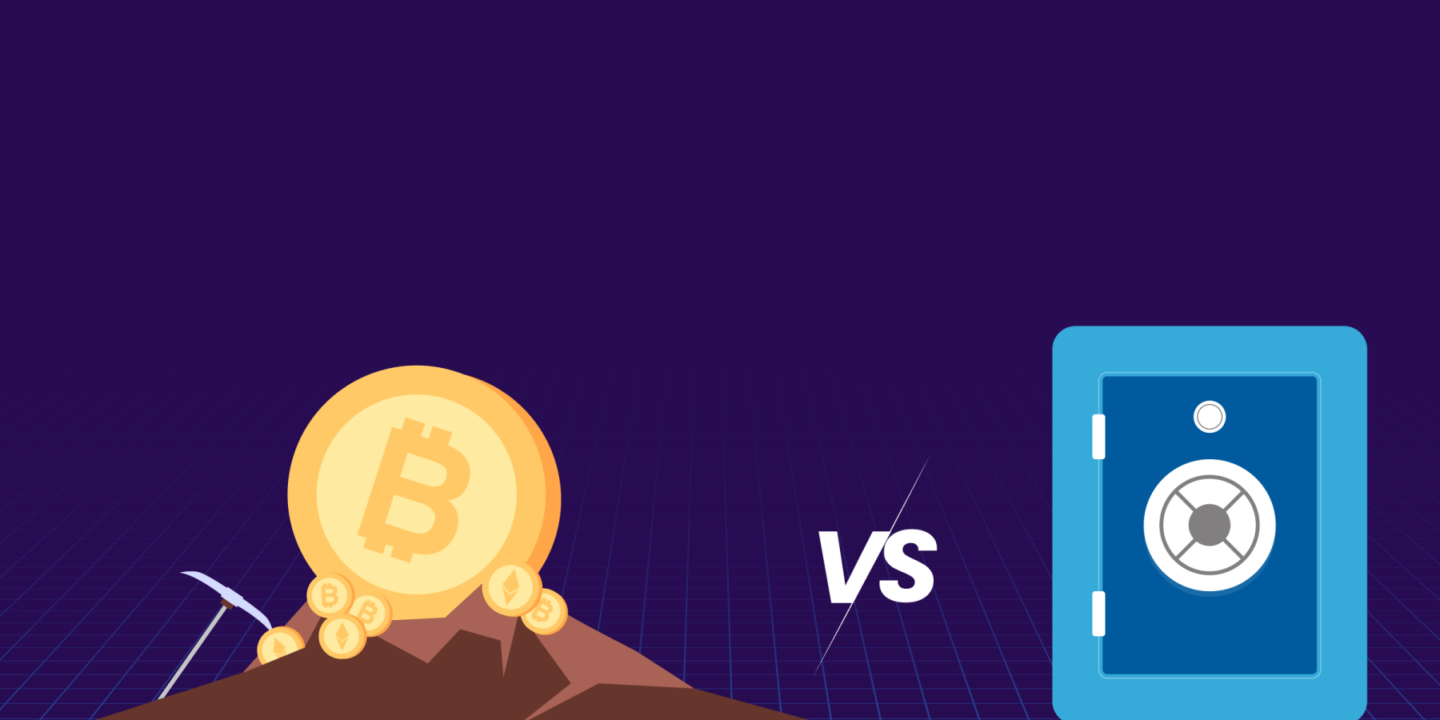
While cryptocurrencies are popular digital assets, what’s more interesting is the technology behind securing crypto transactions. Majorly two consensus mechanisms are used for this specific purpose: Proof-of-Work and Proof-of-Stake. Both these mechanisms are based on the core factor that they ensure that transactions added to the crypto ecosystem are valid and there is no scope for any fraudulent activities.
The question or we can say a hot debatable topic is which one would be the winner in the battle of proof-of-work vs. proof-of-stake?
What Is the Difference Between Proof-of-Work and Proof-of-Stake?
Cryptocurrencies are based on blockchain, which is a decentralized ledger technology.
Unlike a banking system where all the control over all the account holders’ deposits and data is with a single centralized authority, which is responsible for processing transactions, cryptos do not have any single authority managing their network. The control and, thus, the responsibility of processing transactions is distributed among a computer network’s nodes (computers). They verify new transactions and add them as a new data block to the system.
Some cryptos like Bitcoin use proof-of-work to undertake this verification process, whereas Ethereum 2.0 and Cardano use a proof-of-stake mechanism.
Now, let’s understand each of these individually.
But before that, here’s a pro tip – If you want to invest in cryptocurrencies like a pro, Download Mudrex and get started with Coin Sets. They are expert-managed crypto funds based on themes like Blue-chip, Metaverse, NFT and more.
Going back to the topic…
Proof-of-Work
In proof of work, the nodes of the network, also called miners, solve complex mathematical puzzles to verify transactions and add a block to the blockchain. They are rewarded with cryptos in exchange. Various miners compete for an opportunity to add the block; whoever solves the puzzle first gets the chance.
As a result, we can say that this consensus mechanism uses a lot of electricity and resources. Read in detail about proof-of-work here.
Proof-of-Stake
In proof-of-stake, transactions are validated not by solving any mathematical puzzle but by staking your cryptos on the network. Instead of competing with each other, validators in proof-of-stake stake their cryptos, and an algorithm randomly selects a validator. The more crypto you stake, the better your chances of being selected.
Since this does not involve solving puzzles and there is no competition, the resources used are comparatively less when compared to proof-of-stake. This makes PoS more energy efficient. Learn in detail about proof-of-stake here.
PoW vs. PoS: Which Consensus Mechanism Is Better?
While PoW and PoS both intend to secure the transactions added to the blockchain system, they come with their list of pros and cons.
Pros and cons of PoW
Let’s first look at the advantages and disadvantages of the proof-of-work consensus mechanism.
Pros
1. Battle-tested
PoW is a proven mechanism to ensure the safety of transactions. Various top cryptos like Bitcoin and Ethereum use proof-of-work, and over the years, it has proven itself to be the safest way of processing transactions on the blockchain.
Since many nodes compete against each other, it is very difficult to wrongfully validate a transaction on a network that uses PoW.
2. Attractive rewards for successful miners
If a miner successfully adds the block to the blockchain, they are rewarded with a few cryptocurrencies on top of a portion of the transaction fees. For example, currently, miners earn 6.25 BTC for adding each block.
Cons
1. Higher energy usage
This is one of the major issues with the proof-of-work mechanism. For example, Bitcoin consumes more electricity than countries like the Philippines, Finland, and Belgium. This creates concern for its long-term viability and sustainability.
2. Higher expenses
Installing the equipment required to validate and add blocks is expensive. Normal computers do not work for solving cryptographic equations; thus, miners have to install special resources for that. Also, these computers need to run constantly to survive in the competition, which increases the cost related to electricity. All in all, the entire process is very costly.
Pros and cons of PoS
Pros
1. Energy and resource efficiency
Compared to PoW, the PoS consensus mechanism consumes less power and is more efficient. Unlike proof-of-work, in PoS, the algorithm decides the validator and eliminates the competition. Thus, there is no need to constantly burn resources to win the match of validating blocks first. Also, there is no need to install any special equipment for proof-of-stake. Even with a normal laptop, you can validate transactions. The software, too, is quite affordable for validators.
2. Easy to enter the space
Proof-of stake makes mining very convenient and affordable for validators. They do not need to install heavy equipment, and their investment is mainly for buying more and more tokens to stake. This motivates and allows more participants to enter and gain rewards. It is much easier to mine via proof-of-stake compared to proof-of-work.
Cons
1. Yet to be effective on a larger scale
Ethereum 2.0 and Cardano are the two popular examples of proof-of-stake. However, Ethereum has not yet moved to PoS, and Cardano is still a comparatively small network. In comparison, Bitcoin has been using PoW ever since its inception. So PoS is yet to prove itself as a better solution for larger networks.
2. Prone to security breaches
Proof-of-stake has open gates for new participants with lower entry barriers. However, from a security perspective, it cannot stand against proof of work, given that this consensus mechanism has prevailed since Bitcoin was invented.
4. Manipulation by leading token holders
In PoS, a validator with a higher stake has more chances of being selected. Thus, when deep-pocketed validators buy more tokens, they have ultimate control over the system.
When Should PoS or PoW Be Used?
Which one to use in proof-of-work vs. proof-of-stake is a matter of what the network needs are. While both these consensus mechanisms ensure the safety of the overall system, they are different.
In proof of work vs. proof of stake, PoW is used when the primary task is preventing fraudulent activities and increasing the trust factor. PoW makes it almost impossible to tamper with data when it’s being added and after it’s added. The threat of any malicious activities becomes very less.
However, at the same time, PoW takes around 10 to 60 minutes to complete and validate a transaction. Thus, if a faster transaction speed is the need, proof-of-stake is the suitable mechanism. While PoW is comparatively secure, PoS is also a safe framework given that the validators own a majority of the tokens in the network, and thus it is in their interest to protect the system.
FAQs
1. Will proof-of-stake replace proof-of-work?
As of now, there is nothing like one of these mechanisms replacing the other. Proof-of-work helps prioritize transaction security, while proof-of-stake ensures a faster transaction time. There are many differences between these mechanisms, and both could be widely used in the long term.
2. Why is proof-of-work more secure than proof-of-stake?
In proof-of-work, the process of validating transactions is a competition between miners that constantly runs until a block is added. There are no biases in the process; whoever solves the mathematical equation first becomes the winner and gets rewarded. While in proof of stake, validators with the highest tokens put as stake have a higher probability of getting selected and winning rewards. Also, compared to PoW, PoS has lower barriers to entry with fewer expenses and resources required. This allows anyone to enter at any time, making the system prone to fraudulent activities.
3. Is ETH proof-of-work or stake?
The Ethereum network is based on the proof-of-work algorithm; however, to enhance scalability, it will soon undergo an upgrade that will move it to proof-of-stake. This may happen sometime in Sept 2022.
4. Is Bitcoin Cash proof of work or stake?
Bitcoin Cash, just like Bitcoin, is based on proof-of-work. It is a fork of the original Bitcoin network that was created when the community could not reach a consensus on increasing the block size of the original Bitcoin network.





